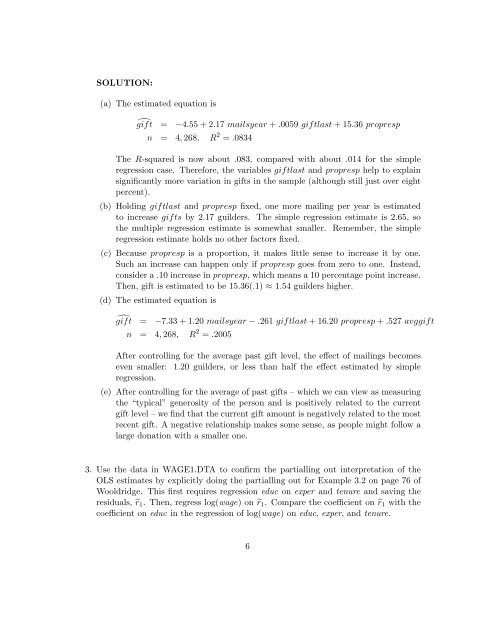Tutorial 8.pdf - Vula
Tutorial 8.pdf - Vula
Tutorial 8.pdf - Vula
- No tags were found...
Create successful ePaper yourself
Turn your PDF publications into a flip-book with our unique Google optimized e-Paper software.
SOLUTION:(a) The estimated equation isĝift = −4.55 + 2.17 mailsyear + .0059 giftlast + 15.36 proprespn = 4, 268, R 2 = .0834The R-squared is now about .083, compared with about .014 for the simpleregression case. Therefore, the variables giftlast and propresp help to explainsignificantly more variation in gifts in the sample (although still just over eightpercent).(b) Holding giftlast and propresp fixed, one more mailing per year is estimatedto increase gifts by 2.17 guilders. The simple regression estimate is 2.65, sothe multiple regression estimate is somewhat smaller. Remember, the simpleregression estimate holds no other factors fixed.(c) Because propresp is a proportion, it makes little sense to increase it by one.Such an increase can happen only if propresp goes from zero to one. Instead,consider a .10 increase in propresp, which means a 10 percentage point increase.Then, gift is estimated to be 15.36(.1) ≈ 1.54 guilders higher.(d) The estimated equation isĝift = −7.33 + 1.20 mailsyear − .261 giftlast + 16.20 propresp + .527 avggiftn = 4, 268, R 2 = .2005After controlling for the average past gift level, the effect of mailings becomeseven smaller: 1.20 guilders, or less than half the effect estimated by simpleregression.(e) After controlling for the average of past gifts – which we can view as measuringthe “typical” generosity of the person and is positively related to the currentgift level – we find that the current gift amount is negatively related to the mostrecent gift. A negative relationship makes some sense, as people might follow alarge donation with a smaller one.3. Use the data in WAGE1.DTA to confirm the partialling out interpretation of theOLS estimates by explicitly doing the partialling out for Example 3.2 on page 76 ofWooldridge. This first requires regression educ on exper and tenure and saving theresiduals, ̂r 1 . Then, regress log(wage) on ̂r 1 . Compare the coefficient on ̂r 1 with thecoefficient on educ in the regression of log(wage) on educ, exper, and tenure.6
















